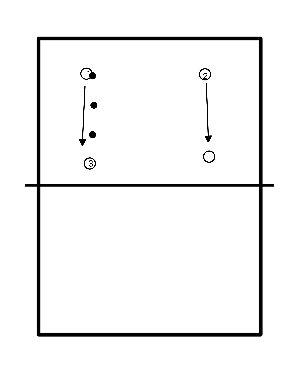Hockey drills
- The group is positioned in the four corners of the field.
- One who tags has to wear a party ribbon
- On a sign, they cross the field in three directions of their choice:
- the short side, the long side or diagonal.
- This results in one, two or three points each time they return.
- A tagger operates in the free space and obliges the tagged children to first go back to their corner before they may cross again.
- How many points can you score in a set time?
- The group is lined up on the short side of the field for a relay.
- On a sign they all run to the other side at the same time and try to sit down as soon as possible in a random order.
- Which line-up will be the first to sit down?
- Variation
- Varying start and end positions.
- Touching a line on the opposite side, returning and sitting in line again.
- This is a good exercise for conditioning:
- The group has to stand in a row and you let them start dribbling.
- As soon as the trainer blows his whistle, the last one of the row should run forwards.
- You do this until everyone has been there and then you let them finish running the track.
- Let the team run for about five minutes and then continue with the following exercises:
- put out the pilons as shown in figure one.
- Have the team make two rows on the sideline at the height of the 23-metre line.
- Perform the following running exercises on the dotted line:
- - Knee lifting (constructive 50%, 80%, 100%).
- - Heel to buttocks (building 50%, 80%, 100%).
- - Sideways
- - Cross step.
- - And finally, release the arms.
- The exercise is meant to simulate a game.
- It is therefore intended that one team consists of the defenders/defending midfielders and the other team consists of the attackers.
- The attackers can score in the normal goal (decide if they can hit high as in the game).
- The defending side can score by driving the ball.
- Over the line of the goals on the half way line.
- The attackers learn to play over and finish at goal and the defending side learns to defend to the outside.
- Flat
- Open reception,
- Accelerate & push pass out of the barrel (alternate with other techniques such as stroke, push pass, backhand pass).
- A flats to B (A runs after own ball);
- B takes it open and runs around the pilon.
- B accelerates with the ball stuck to the stick and plays the ball through the gates to A.
- Resumption
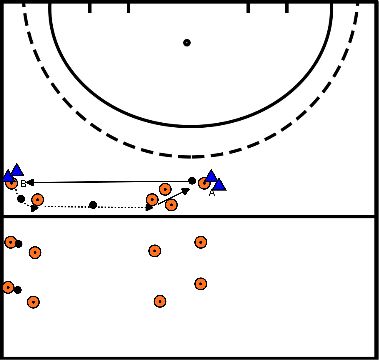
- From the back line to 23 m line in 30 sec 3x back & forth.
- 30 sec rest, then repeat.
- H1 level 4x (start competition half) 80% within time should be achievable.
- Pay attention to turning speed.
- Start low to quickly get on track.
- Carry energy in the turn.
- For larger groups, make 2 groups.
- Group one start on back line, group two on 23 meter line. When group one is running, group two is resting (30 seconds).
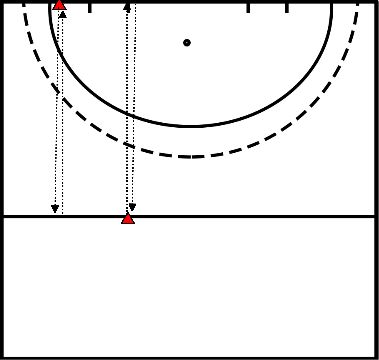
- Two teams with subs, there's a change if there's a score.
- Each person defends a goal, there are five goals on each field, so there are also five people defending these goals.
- If a goal is scored in your goal, you have to sit on the side and switch.
- A new player (sub) enters the field from the side and defends the goal.
- If there's a goal, it's a point.
- The team with the most points at the end of the match is the winner.
- The exercises can be played in 2 variations: the one for real beginning hockey players (this exercise can be used for a clinic for example) and the one for beginning hockey players who have already been in contact with hockey.
- Variant 1:
- Player 1 plays the ball to player 2, he takes the ball and passes on to player 3.
- Player 3 takes the ball and shoots at goal.
- Player 4 tries to stop the ball with the bottom of the foot or with the stick.
- Player 4 picks up the ball and joins the row at the back of the starting pilon of player 1.
- For safety's sake, don't shoot at goal when player 4 takes the ball.
- The balls can also be taken out of the goal later on or use a break for that.
- This is for safety reasons.
- A passes deep to B, B goes around behind pilons and gives the ball to A in front, A scores on goal;
- B goes back to position, offers himself and gets the ball from C. CB play a 2v1 against A;
- A enters the ball at D gets ball and plays (D, E and A) a 3v2 against CB.
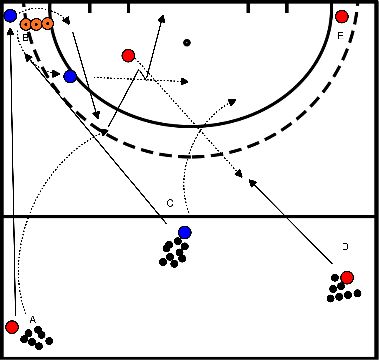
open and closed receptions
- Number one calls "open" or "closed" and then plays the ball to number two.
- Number two comes running into the ball and takes it on according to what was called.
- Then number two calls "open" or "closed" and plays the ball to number three.
- Number three enters the ball and takes it on according to what was called again.
- Then number three runs over the back line into the circle and plays it at the head of the circle to number four.
- Number four finishes on target.
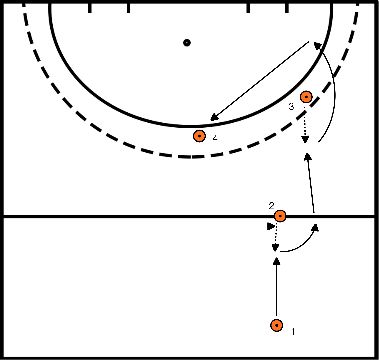
- put out a square as shown in the drawing.
- Make teams of 3 people.
- There must always be one pilon open.
- Start with the ball at person 1, person must always have 2 possibilities.
- If person 1 passes to person 3, person 2 must move one square.
- This is how the exercise continues.
